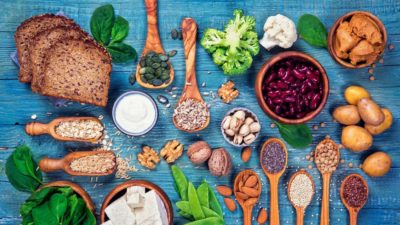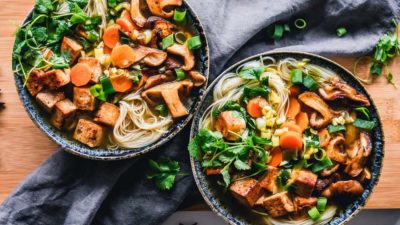Fuelling your performance

When you switch to plants as your main fuel, your body will reward you with more energy, better stamina, easier breathing and faster recovery. The best part is that there’s nothing complicated about a vegan diet. The key is to focus on these food groups: fruits and vegetables, wholegrains, pulses, nuts and seeds.
As an athlete, you need long-lasting energy and that means healthy complex carbohydrates. The best sources include wholegrains (eg wholemeal bread, whole wheat pasta, brown rice, muesli/granola/oatmeal, buckwheat, quinoa), starchy vegetables (eg sweet potatoes, root vegetables, squashes and pumpkins, peas and corn) and fruit (fresh and dried). These foods are important whether you’re training for strength, endurance, weight-loss or general fitness – without them, your energy will be flagging.
Your hard-working muscles also need protein and antioxidants for efficient and speedy repair. The best sources of these are pulses (eg beans, lentils, chickpeas and soya) and products made from them (eg burgers, falafel and hummus), nuts and seeds, and wholegrains. Yes, wholegrains like oats or wholemeal bread pack a decent protein portion! Plant-based protein powders may be a useful addition to your diet if you have higher protein requirements or no time to eat – they offer some clean lean protein – but you don’t necessarily need them, as long as you eat enough calories.
Lastly, you also need some healthy fats. We don’t need much fat but we do need the right kind as it’s crucial to your performance and blood pressure regulation. To get the all-important omega-3 unsaturated fats, add some chia seeds, flaxseed, hemp seed or walnuts to your daily regime.
When you power your body with plants, all their antioxidants and health-protective phytochemicals truly help you to thrive. The bright colours of fruit, vegetables, beans and lentils are not just nice to look at, all of these pigments have some pretty powerful disease-busting properties and they help you achieve faster recovery times after training.
There’s a lot of discussion about the best macronutrient ratios and you’ll find our recommended ranges below. These recommendations will supply your body with exactly what it needs according to modern nutrition science – but we are all different so you’ll have to fine-tune your diet to suit your particular needs. We have outlined the nutrient and calorie requirements for four different activity patterns:
1. Moderately Active Person – 2-3 moderate workouts per week, some activity at weekends
| Carbs | 2.3-2.7 g/lb of body weight (5-6 g/kg) |
| Protein | 0.4 g/lb of body weight (0.8 g/kg) |
| Fat | 0.2-0.7 g/lb of body weight (0.5-1.5 g/kg) |
| Total energy | 2,000-2,500 kcal |
2. Active Person – daily physical activity, some aerobic exercise (runs up to 5k, cycling, swimming), muscle toning, hiking, rock-climbing
| Carbs | 2.3-3.6 g/lb of body weight (5-8 g/kg) |
| Protein | 0.4-0.5 g/lb of body weight (0.8-1 g/kg) |
| Fat | 0.2-0.7 g/lb of body weight (0.5-1.5 g/kg) |
| Total energy | 2,200-2,900 kcal |
3. Endurance Athlete – prolonged (60min+) training 4-5 times per week: running, cycling, ball games, swimming, kayaking/rowing
| Carbs | 2.7-5.4 g/lb of body weight (6-12 g/kg) |
| Protein | 0.5-0.7 g/lb of body weight (1.2-1.4 g/kg) |
| Fat | 0.2-0.7 g/lb of body weight (0.5-1.5 g/kg) |
| Total energy | 2,500-3,500 kcal |
4. Strength Athlete/ Bodybuilder – resistance training with the goal of increasing muscle mass and strength, weight-lifting, intense CrossFit
| Carbs | 2.7-5.4 g/lb of body weight (6-12 g/kg) |
| Protein | 0.7-1 g/lb of body weight (1.6-2 g/kg) |
| Fat | 0.2-0.7 g/lb of body weight (0.5-1.5 g/kg) |
| Total energy | 2,500-4,500 kcal |
Now you know how much of each macronutrient you need and how many calories, it’s time to put this knowledge into practice. It’s easy to get the right amounts of all these nutrients from the plant foods mentioned above, but don’t worry, we have a lot more resources! Here’s our guidance on How to Plan Your Meals and Sample Meal Plans. Or, if you’d like to know more about the Essential Food Groups, we have you covered too!
Before – focus on carbs. Exercising on a full stomach is a big no, so always leave at least 2-3 hours after a main meal before you start any kind of exercise. However, a small snack around 30 minutes before you start training can be helpful. It should be carb-based for an energy boost – a piece of fresh fruit, a few pieces of dried fruit, an energy bar or a smoothie.
During – focus on hydration and electrolytes. During 60-minute workouts, you only need water to stay hydrated. If you train for longer though, or extra hard, have an isotonic drink to replenish your electrolytes – minerals lost through sweating – and some sugar for an energy boost. You can easily make your own: combine 300 ml water with 200 ml fresh/cold-pressed fruit juice, and a small pinch of salt. To make it more exciting, you can add some ginger or fruit slices – or a teaspoon of brown sugar for added energy.
If you are an endurance athlete, you may also need a quick snack during your training – please check our Snacks section for some exciting ideas!
After – focus on protein and carbs. To support your muscle recovery and energy restoration, you should eat or drink something you digest quickly within 45 minutes of finishing your training. Your muscles need protein and your glycogen energy stores need carbs. The easiest option is a smoothie/shake or a protein bar and some fruit. You need about 0.45 g of carbs per pound of body weight (or 1 g per kg) and 20-40 g of protein. Be prepared and make a fresh smoothie at home before you get started; throw in some protein powder, nut butter or chia seeds and you’re sorted! A good old sandwich, wrap or a pack of nuts and dates are also good options. See our Snacks section for a lot more ideas!

“I was plant-based for most of my pro hockey career and continue to live that lifestyle today. Once I made the change, I felt healthier, had more energy, and had less inflammation which leads to quicker recovery.”
Michael Zigomanis, retired NHL player, Stanley Cup champion
Making sure you are well hydrated is as important as a healthy diet. The human body is about 60-65 per cent water and we need to keep replenishing it to maintain blood volume, joint lubrication, kidneys flushing out waste and toxins, body temperature regulation through sweating, and breathing. Water is also essential for all our cells, mucous membranes, saliva, digestive juices and many vital reactions.
You need at least two litres every day. When you’re active or it’s extra hot outside, you need even more. It’s a simple equation: the more you sweat, the more water you need to drink to replace it.
Water is generally best during moderate workouts whilst an isotonic drink can be helpful for endurance athletes (as mentioned above). Outside of training, tea is also a great option – herbal tea is perfect for hydration and contains no caffeine. Caffeine can slightly increase stamina, however, so many of us turn to caffeinated drinks for a boost. Your body absorbs caffeine from drinks very quickly and peak concentration in the blood occurs 15-120 minutes after ingestion. The effect lasts for up to six hours but doubles in women taking oral contraceptives! Caffeine sensitivity varies from person to person, so it’s difficult to prescribe an effective dose. Coffee contains the most caffeine, followed by black tea and then green tea. The good news is that coffee and tea are also good sources of antioxidants, so a sensible consumption of up to five cups a day is not bad!
If you prefer caffeinated soft drinks, we have some bad news – they are full of sugar and chemicals and usually devoid of antioxidants or anything healthy, so you’re best off staying away from those.
Next on the drinks list are juices and smoothies. These drinks range from super healthy to super unhealthy. A glass of fresh or cold-pressed juice daily is a sound choice. A freshly made smoothie is even better because it contains whole fruits and vegetables. The key word is ‘fresh’ and it means these drinks contain vitamins, minerals, antioxidants and some beneficial compounds such as flavonoids – and fibre if it’s a smoothie.
Any other option is not so great. The juice you buy in ‘normal’ shops may or may not be made from concentrate but it’s almost always pasteurised. That means the juice (or smoothie) is exposed to high heat which kills off any potentially harmful microbes, but it also kills off much of the goodness in the juice. It retains little of its vitamin content and there isn’t much else left aside from some sugar. All the fruit drinks sold in cartons have undergone pasteurisation; many are made from concentrate and sweetened too, so not worth your money. The best option is to take a few pieces of fruit (and veg), throw them in a blender and make a fresh smoothie to go – it’s the healthiest and often cheapest option.






